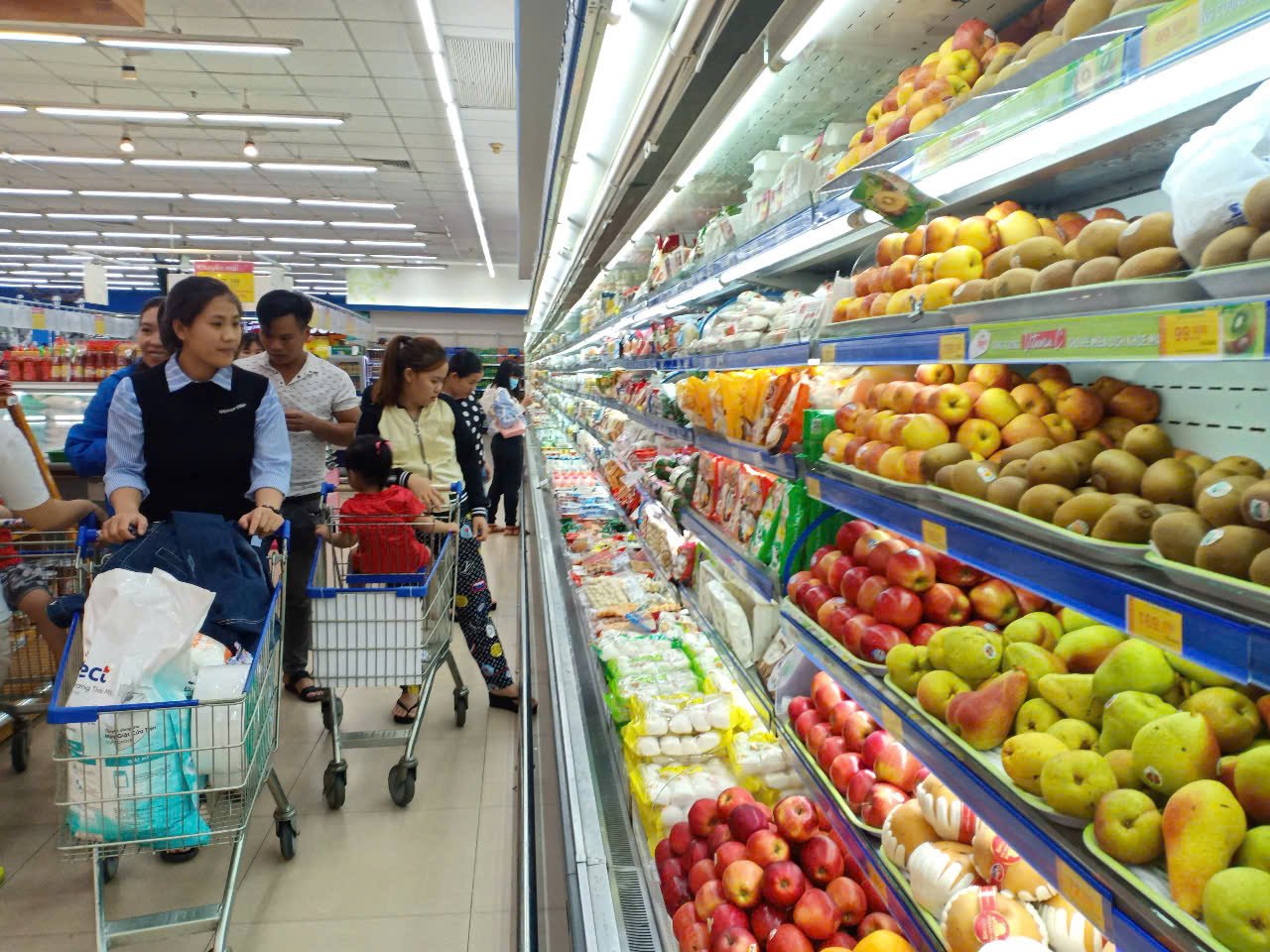 |
| Phu Yen consumers choose to buy products at a shopping mall in Tuy Hoa City and often use cashless payment methods. Photo: PV |
The plan aims to optimize the entire value chain from production to consumption through technological solutions, ensuring a balance between economic growth, social equity and environmental protection. One of the important highlights is the requirement to organize the e-commerce development space in a synchronous and effective manner nationwide; at the same time, promote regional and international linkages to mobilize and effectively use resources. Enterprises and consumers are the main forces in sustainable e-commerce development.
Enhance value and competitiveness
According to Minister of Industry and Trade Nguyen Hong Dien, the plan aims to enhance the value and competitiveness of e-commerce, promote the consumption of Vietnamese products through e-commerce both domestically and internationally; narrow the gap in e-commerce development between localities; develop e-commerce in a green and circular direction, contributing to building a fair and sustainable society.
Specifically, Vietnam aims for 70% of the adult population to participate in online shopping; e-commerce retail sales to grow by 20-30% per year, accounting for 20% of total national retail sales; reducing the rate of websites violating consumer rights to 5-10%. Strive for 70% of businesses to apply e-commerce, 100% of transactions to have electronic invoices, 80% of non-cash payment transactions, and 60% of small and medium enterprises to operate on e-commerce platforms.
Notably, the green and sustainable development factor is included as a pillar with specific targets: reducing the rate of plastic packaging to a maximum of 45%, increasing the rate of recycled packaging to 50%, at least 40% of businesses using clean energy in e-commerce logistics and 50% of businesses applying green packaging standards.
E-commerce is a pioneering field of the digital economy. E-commerce development focuses on sustainable development, aiming to optimize the process from production, business to consumer experience with solutions that have a positive impact and balance between the three factors of economic development, social equity and environmental protection. Of these, businesses and consumers are the main forces in sustainable e-commerce development, the State has a role in managing, building infrastructure, and creating conditions for the sustainable development of e-commerce.
Minister of Industry and Trade Nguyen Hong Dien
The plan sets out 6 key tasks and solutions to realize the set goals. Specifically, focus on building and perfecting institutions, including mechanisms and policies for state management and developing the e-commerce market. At the same time, perfecting infrastructure for sustainable development, including digital infrastructure, logistics infrastructure and cashless payment systems. Building core platforms and systems to serve both state management and a green, sustainable e-commerce market.
The leader of the provincial Department of Industry and Trade said that in order to achieve the goals of the national e-commerce development plan for the period 2026-2030, in the coming time, the Department of Industry and Trade will advise the Provincial People's Committee to organize training courses on e-commerce knowledge and skills, equipping modern means for the team of law enforcement on e-commerce; thereby supporting the monitoring, supervision, dispute resolution, and handling of violations of e-commerce activities in the online environment. There are policies to encourage people, businesses and related organizations to use non-cash payment services in e-commerce activities. Update policies to facilitate all economic sectors and production and business establishments to participate in trade promotion activities and events, and consume products and goods in cyberspace. In addition, build an inter-sectoral coordination mechanism and form a rapid response force to promptly handle acts of smuggling, trade fraud, trading in counterfeit goods, goods violating intellectual property rights and unfair competition in e-commerce.
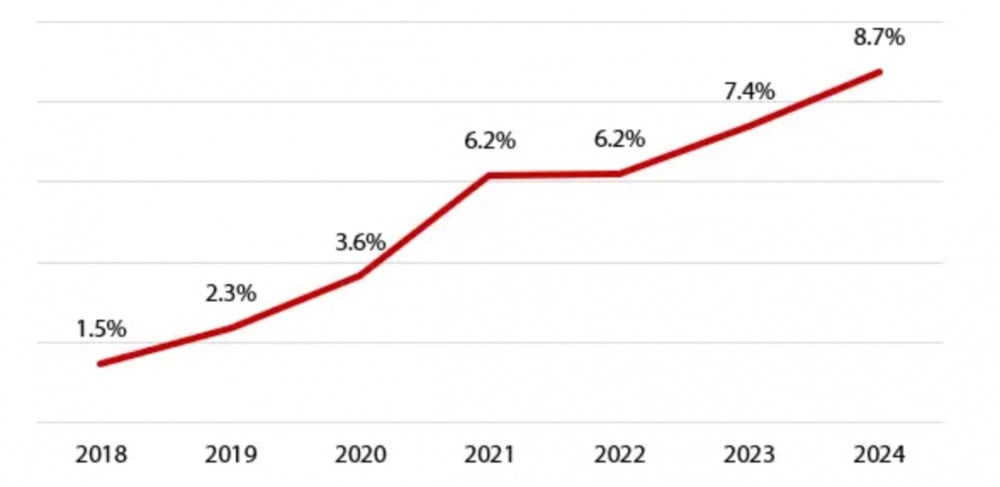 |
| Market share of Vietnam's e-commerce in total retail sales of goods in Vietnam. (Source: Google, Temasek, Bain & Company, Fiinpro, Rong Viet Securities). Graphics: TCCT |
Many forms of support for businesses and people
To develop e-commerce, previously, the People's Committee of Phu Yen province issued a plan to develop e-commerce in the province by 2025, with the goal of 40% of the population participating in online shopping; 70% of e-commerce websites of businesses and business establishments in the province have integrated online ordering functions; 50% of small and medium enterprises conduct business activities on e-commerce trading platforms, including social networks with e-commerce trading platform functions; 40% of businesses participate in e-commerce activities on mobile applications; 70% of electricity, water, telecommunications and media service providers in the province implement electronic contracts with consumers.
For example, the provincial Department of Industry and Trade coordinated with the Vietnam E-commerce Association in the Central Highlands region to activate the e-commerce application program and digital payment solutions at Tuy Hoa market. In addition, the provincial Department of Industry and Trade conducted a survey on the needs and capacity of small traders at Tuy Hoa market, supported small traders to introduce products on online platforms, integrated payment accounts with QR codes and piloted a number of stalls selling dried seafood, clothes, shoes, etc. on the TikTok channel.
In the coming time, the Ministry of Industry and Trade will continue to coordinate with other sectors, localities and enterprises to continue exploiting the advantages of e-commerce to promote and bring local products to customers quickly.
Mr. Nguyen Hai Trieu, Deputy Director of Department of Industry and Trade
In addition to supporting small traders at markets, the province has also supported cooperatives and businesses to bring their products to e-commerce platforms, improving the effectiveness of promoting the province's products. Up to now, the unit has supported businesses and production households to promote and introduce 335 local specialty products to the platform, contributing to promoting the development of e-commerce in the area.
To date, most supermarkets, shopping malls and distribution facilities in Phu Yen have applied non-cash payment methods when consumers make purchases. 100% of electricity, water, telecommunications and media service providers have implemented electronic contracts with consumers and accepted payment of service fees from households via electronic means.
On a national scale, a report by the Department of E-commerce and Digital Economy ( Ministry of Industry and Trade ) said that Vietnam's e-commerce continues to maintain an impressive growth rate of 18-25% per year. In 2024, the market size will reach over 25 billion USD, an increase of 20% compared to 2023, accounting for about 9% of total retail sales of goods and consumer service revenue nationwide.
Source: https://baophuyen.vn/kinh-te/202506/huong-den-phat-trien-thuong-mai-dien-tu-ben-vung-1020b53/














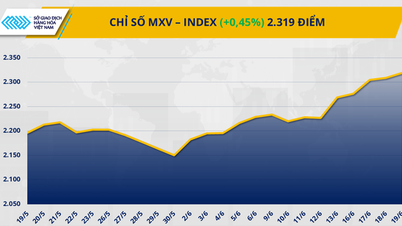










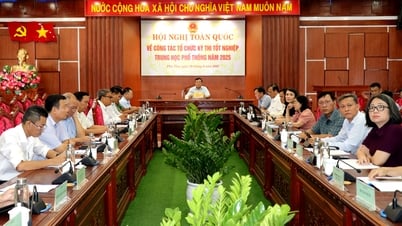
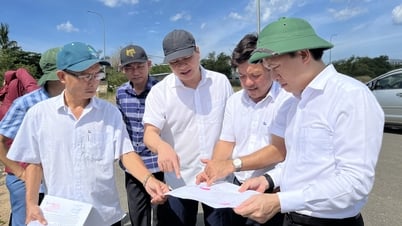


























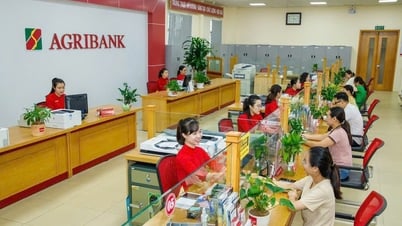
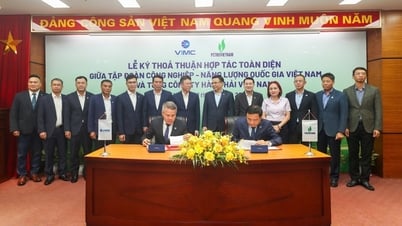
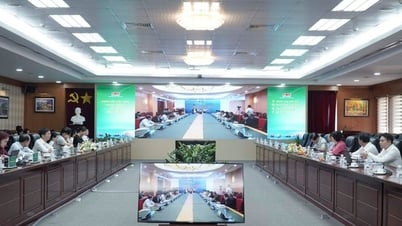

















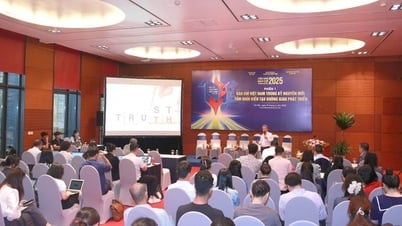

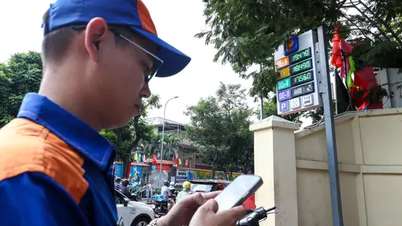























Comment (0)